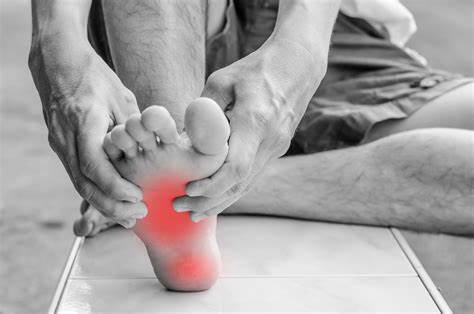+918048039022

This is your website preview.
Currently it only shows your basic business info. Start adding relevant business details such as description, images and products or services to gain your customers attention by using Boost 360 android app / iOS App / web portal.
Plantar fasciitis is the result of collagen degene...

Plantar fasciitis is the result of collagen degeneration of the plantar fascia at the origin, the calcaneal tuberosity of the heel as well as the surrounding perifascial structures. The plantar fascia plays an important role in the normal biomechanics of the foot. The fascia itself is important in providing support for the arch and providing shock absorption. It is characterized by medial heel pain that worsens with weight-bearing, as well as after rest or non-weight bearing. Plantar fasciitis often presents chronically with symptoms lasting over a year in duration. There are many different sources of pain in the plantar heel beside the plantar fascia and therefore the term "Plantar Heel Pain". Planter fascia that thick elastic multilobular fat pad is responsible for absorbing up to 110% of body weight during walking and 250% during running and deforms most during barefoot walking vs. shod walking. Plantar fasciitis is a clinical diagnosis. It is based on your history and physical examination. Person can have local point tenderness along the anteromedial of the calcaneum ( your heel ) , pain on the first steps, or after training. Any activity that would increase the stretch of the plantar fascia, such as walking barefoot without any arch support, climbing stairs, or toe walking can worsen the pain. Clinical Presentation Heel pain with first steps in the morning or after long periods of non-weight bearing Tenderness to the anterior medial heel Limited ROM of ankle joint A limp may be present or may have a preference to toe walking Pain is usually worse when barefoot on hard surfaces and with stair climbing Many patients may have had a sudden increase in their activity level prior to the onset of symptoms Diagnostic Procedure Ultrasonography is the most used imaging modality for this condition, and plantar fascia thickness is most often assessed - meta-analysis showed patients with plantar fasciitis have a plantar fascia 2.16 mm thicker when compared to a control group, and typically had plantar fascia thickness of 4.0 mm and above. Physical therapy in planter fascia Myofascial release can be helpful in reducing pain Stretching exercises for planterfascia Achilles’ tendon stretching can be performed in a standing position Taping to prevent position in incorrect posture Foot orthoses If require If the patient has pain with initial steps in the morning, a night splint would be beneficial. Therapist can guide in weight distribution Footwear should include a rocker-bottom shoe (a shoe which has a thicker-than-normal sole with rounded heel ) Corticosteroid injections have been shown to be beneficial in the short term (less than four weeks) but ineffective in the long term.

